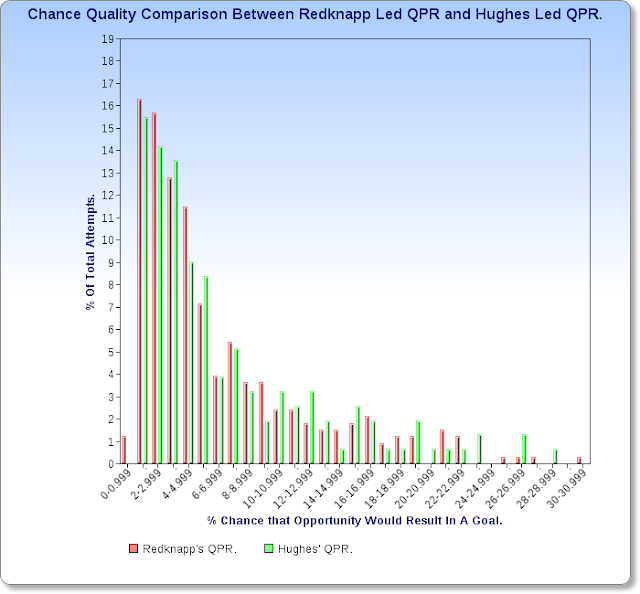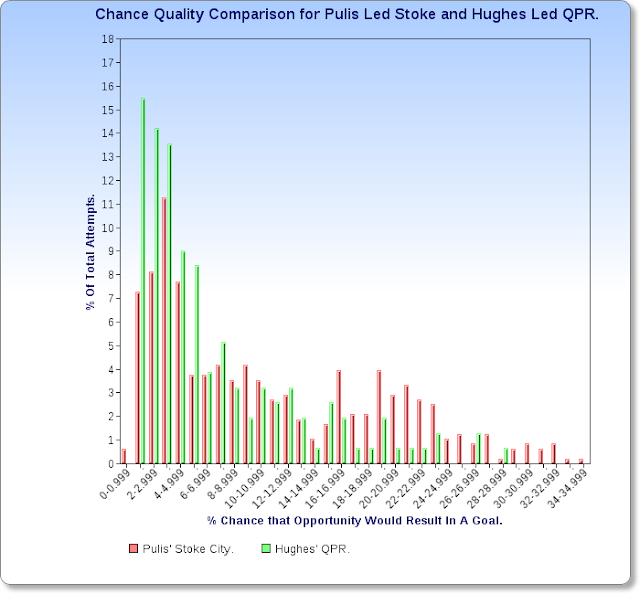The heartfelt cheers that rang out as the Stoke back four spread passes from left to right along the backline, may have been slightly tinged with irony as the process was then repeated in reverse. Possession passing with little end product, as many midtable visitor to the Britannia under the reign of Pulis has discovered, often fails to reap any reward.
A pleasant, sun-drenched and predominately half paced workout did nothing other than reaffirm Hughes' promise to attempt a more pleasing style of play. But elegant, if crab like passing moves against similarly relaxed opponents didn't answer the crucial question.
Can Stoke do it on a wet Wednesday night in the Potteries?
 |
| Wilson pauses before passing to a team-mate situated in the same postcode. |
Tony Pulis' Stoke City have long confounded the general shooting and chance conversion models with their constant overproduction and above average conversion rates, again, especially at the Britannia. It is only when the extra layer of information is added that the "secret" is revealed. Stoke didn't employ lethal, superhuman finishers, they simply created better, lower volume chances, that could be taken closer to goal. Their occasionally novel delivery methods played to their physical advantages by presenting the ball to the striker, or just as frequently, defender in and around the six yard box.
By contrast, Mark Hughes' previous employers, QPR were frequent purchasers of a lottery ticket. While Stoke and the vast majority of QPR's opponents were attempting to craft or bludgeon their way closer to goal, Rangers were content to expend 78 long range, low goal outcome attempts in scoring just once. It is perhaps unfair to attribute all of QPR's optimistic shooting tendencies to Hughes. He merely install the club at the foot of the table, it was left to Harry Redknapp to complete the transition from Premiership to Championship. However, as the plot below appears to illustrate, very little changed with the changing managerial identity.
Dicing the sample causes a few minor peaks and troughs to appear, but essentially the fondness for lots of low quality shots so characteristic of QPR's last season in the top flight appears to have been a tactical characteristic that was approved by both Hughes and Redknapp.
By contrast and in particular when viewed alongside QPR's overall shots allowed and attempted profile here,
a Stoke led by Tony Pulis actively drove their opponents to attempt QPR-like longshots, while keeping the quality chances for themselves.
The frequency with which Stoke's opponents felt compelled to shoot from distance in the final season of full-bloodied Pulisball stands out starkly in the left hand side of the plot. The Potters then inexorably out created their opponents in the richer areas of the penalty area, where the generic chance of a goal reached out to 16% and beyond. The Stoke fans could comfortably encourage their opponents to shot often from distance, safe in the knowledge that Lowton's late season screamer for Aston Villa in 2012/13 was the exception rather than the rule.
Inevitably, the comparisons between the approach of Stoke's current and previous manager has centred around the difference in passing styles. Although, so extreme was Pulis' adherence to the longball both in an attacking way and also as a way of relieving defensive pressure, that virtually any replacement would have appeared to be a move towards more Barca-like values.
However, as the final plot illustrates, a much more fundamental difference exists between the records of each man. With a similar calibre of side, Hughes persevered, unsuccessfully with low goal probability, long-range shots. Over half of the attempts made by QPR under his half season, relegation reign had a less than 5% chance of producing a goal.
By contrast, the much maligned Pulis in his gloriously annoying pomp offered up to the fans over 30% of their side's chances with a 15% or greater chance of scoring attached. All done with an eye still firmly fixed on goal prevention at the other end.
Sacrificing defensive stability for more frequent, lower quality chances and slightly more goals, may result in Stoke gaining promotion under Pulis and slipping back into the Championship under his more illustrious countryman. Superficially, Stoke appear to be joining the mainstream, but they may simply be trialing another, possibly less successful, if more visually appealing, niche market, where long balls are replaced by long shots.



No comments:
Post a Comment